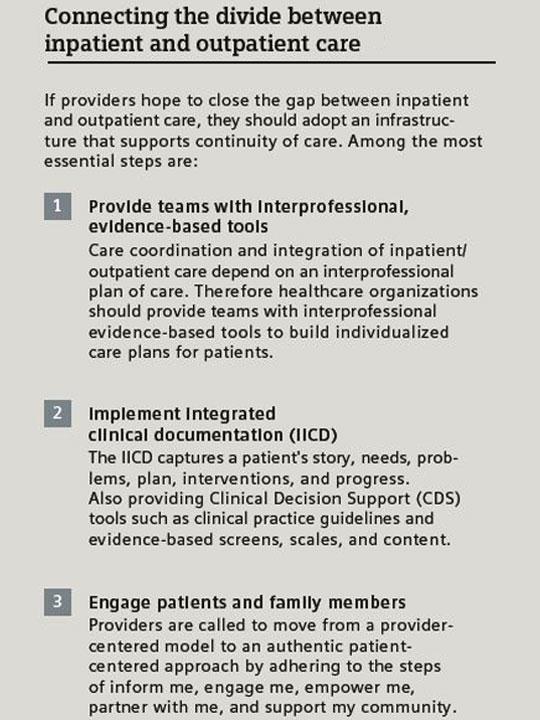Healthcare stakeholders must think beyond their own organization to deliver care more efficiently. To keep up with new environments, they need to radically transform their business strategies. They face major challenges whether they choose to focus on specific services, merge with other organizations, or automate their processes.

In Need of Transformational Change in Healthcare
Today, centrally regulated markets dominate global healthcare systems. They target standardization and efficiency, but the mostly fragmented systems usually incentivize delivered services, not patient-centered outcomes.
One concern with most health system models is that patient care is fragmented by specialty and discrete services, such as primary care, hospital, and rehabilitation. A typical everyday example is the discharge of a patient from a hospital following an intervention. Information flow to the patient’s primary care physician, the specialist performing the follow-up, and even his or her family supporting the recovery at home is scarce and sometimes anecdotal. In the United States, payers have started addressing the problem by introducing readmission penalties that limit payments to hospitals in cases of excessive rates of readmission within a certain period of time after discharge.
Neither patients nor health workers feel that payments reflect the value of care, but everyone agrees that value-based care should be the common goal.

Rethinking Healthcare Delivery Systems
In future, health systems and business models, collaboration between providers from different healthcare sectors and among payers, providers, and industry will be an integral part of a solution based on patient needs. A value-based approach can provide a framework for decision-making and constant adaptation.
Lasting change can occur if healthcare leaders focus on actionable steps and measure progress. There needs to be a shift in physician engagement from a short-term fee-per-service perspective to sustainable patient health outcomes.
Value-based outcome measurements can be implemented to move beyond a binary result of the patient’s improved health: yes or no. For example, hospitals may share the same five-year survival rate for prostate cancer patients, but metrics that incorporate a patient’s quality of life, such as incontinence or severe erectile dysfunction rates, demonstrate significant differences between hospitals. These can be used to provide better care for individual patients earlier. Healthcare providers can improve patient-centered care through specialization on certain diseases, integration across healthcare sectors, and collaboration between local providers and centers of excellence.
Healthcare executives and leaders need to be willing to spend more time evaluating potential partnerships to ensure an ideal balance of skills and resources.

Shaping Tomorrow’s Healthcare Today – A Culture Change in Healthcare
Consolidation, integration, and specialization are typical industry buzzwords. They have also become international healthcare buzzwords and key concepts for driving and shaping changes in health systems.
Consolidation

Consolidation allows all players in healthcare systems, providers in particular, to benefit from integration, specialization, big(ger) data, and increased patient attraction. Providers consolidate through mergers and acquisitions, collaborations, as well as franchising and certification models.
Fragmented healthcare services can erode efforts to maintain a level of value-based care. An answer to this challenge is vertical consolidation across healthcare sectors (primary care, specialist, hospital, and rehabilitation) along the patient value chain. Horizontal consolidation among providers in the same sector, such as hospitals, enables economies of scale (for example, in purchasing and process optimization), and sharing the workload between local providers and centers of excellence. The fact that a consolidated institution is, at the same time, close to their patients’ homes and able to provide the appropriate level of care even for the most challenging cases makes them more attractive to their customers. If they solve the challenge of aligning their IT systems and addressing data privacy issues, consolidated institutions have access to a larger patient data pool that they can use to drive clinical studies and generate medical and organizational evidence.
Integration

Multidisciplinary healthcare teams must collaborate to achieve desired patient outcomes and share the burden of risk and costs. IT can facilitate this process by enabling consultations with physicians and nurses, and improving communication and information flow.
Integration helps avoid redundant tests or administrative tasks and reduces the risk of errors due to information gaps, for example about incompatible drugs and allergies. On a larger scale, the evolutionary steps of healthcare integration can be illustrated by the concepts of service provider, episode integrator, and population manager. The service provider offers treatment within a narrow range of highly specialized services, typically tied to fee-for-service reimbursement. An episode integrator, such as an oncologist, integrates acute care across separate specialties within a hospital as well as outpatient care and follow-up. A population manager optimizes the health of a certain population, usually a defined number of enrollees within a certain territory, e.g. in the United States. These new models can be contracted by commercial payers, government-funded payers, and employers to optimize the result-versus-cost ratio of care delivery across an entire population – from nutrition education of school children to elder care. Such an approach could even facilitate structured changes across an entire healthcare system.
Specialization

Patient care can be managed by specific medical conditions, while at the same time, taking into account different specializations, services, and common comorbidities. As healthcare systems adopt a more evidence-based approach to care, specialized provider networks can lead the way in achieving higher case numbers, building up better dedicated expertise, implementing guidelines, and offering state-of-the-art services and tools.
Healthcare executives have found that specialization can help improve workflows and cut back on errors or oversights. Care paths and workflows can be optimized for a specific disease condition, such as stroke or acute myocardial infarction. And of course, this works best with a specialized team. By focusing on patients with a certain medical condition, clinicians and non-clinicians are more aware of costs per services and how they affect the total fee of the care cycle. They can optimize patient outcomes and still contain costs by providing the right level of care for the individual patient in the appropriate higher or lower cost setting.
